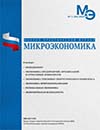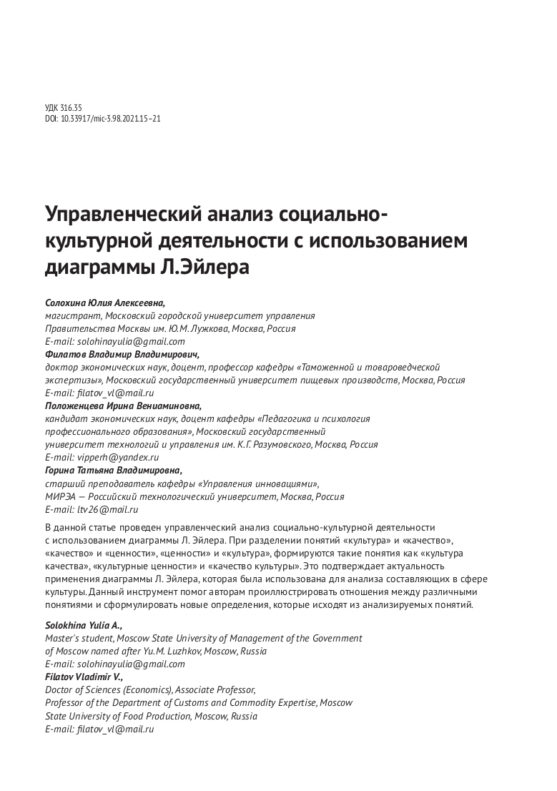Managerial analysis of socio-cultural activities using the L. Euler diagram
DOI: 10.33917/mic-3.98.2021.15-21
This article presents a managerial analysis of socio-cultural activities using the L. Euler diagram. When separating the concepts of «culture» and «quality», «quality» and «values», «values» and «culture», such concepts as «quality culture», «cultural values» and «quality of culture» are formed. This confirms the relevance of the use of L. Euler diagrams, which were used to analyze the components in the field of culture. This tool helped the authors to illustrate the relationships between different concepts and to formulate new definitions that come from the analyzed concepts.
References:
1. Bekbaeva Zh. S., Polozhentseva I. V. Formation of information culture in the digital economy //Chief mechanic. 2019. No. 8. pp. 62-66.
2. Euler L. Method of finding curved lines with properties of maximum or minimum, or solution of an isoperimetric problem taken in the broadest sense. M.; L.: Gostekhizdat, 1934. 600 p.
3. Lukashov I. M., Korabelnikova A. A., Minaichenkova E. I., Polozhentseva I. V. Managerial analysis of the national project «Demography» using Euler-Venn diagrams //Journal of Applied Research. Scientific and practical journal. 2021. No. 1. volume 2. pp. 25-35.
4. Mosyakin T. D., Minaichenkova E. I., Polozhentseva I. V. Analysis of the categories quality and values from the point of view of psychology, sociology and economics //Journal of Applied Research. Scientific and practical journal. 2021. No. 1. volume 2. pp. 41-44.
5. Michael McCarthy. Cambridge International Dictionary of Idioms. United Kingdom at the University Press, Cambridge, 608 p.
6. Ayvazyan N. L., Bezpalov V. V., Bespalova E. S., Gaivoronskaya S. A., Zharikov R. V., Zima E. A., Kalinina O. V., Krug E. A., Kucheryavenko S. A., Lipka V. M., Loginova I. V., Nazarova A. N., Pryadko S. N., Puchka O. V., Razinkina E. M., Rapatsky Yu. L., Sinelnikova N. A., Sergeev S. V., Stenyushkina S. G., Thorikov B. A., etc. E. Deming’s concepts in quality management. Monograph. Publishing house: Belgorod State National Research University, Belgorod, 2020. 178 p.
7. Kobiashvili N. A., Zhenzhebir V. N., Osinskaya T. V., Fadeev A. S., Medvedev V. M., Shestov A.V., Kretov M. I. Improving the efficiency of the enterprise quality management system based on the optimization of the functional subsystem //Online journal of Science Studies. 2015. Vol. 7. No. 3 (28). p. 42.
8. Dorofeev A. Yu., Polozhentseva I. V., Filatov V. V. Transition from value to value and from value to fundamental value //Questions of Economic Sciences. 2011. No. 2 (47). pp. 7-11.
9. Rukina I. M., Filatov V. V. The role of fundamental values in social development //Microeconomics. 2017. No. 4. pp. 107-116.
10. Lyubina O. N. Innovative culture as an object of philosophical analysis //Managing a megalopolis. 2012. No. 6 (30). pp. 139-145.
11. Lyubina O. N. Modern approaches to the definition of innovative culture of society //Information humanitarian portal Knowledge. Understanding. Skill. 2012. No. 6. p. 11.
12. Lyubina O. N. Culture of the state civil service: problems of resistance to innovations //Bulletin of the University. 2015. No. 6. pp. 280-283.
13. Lyubina O. N. Culture of professional communications of civil civil servants: traditions and innovations //Managing a megalopolis. 2012. No. 4. pp. 140-144.
14. Bekbaeva Zh. S., Polozhentseva I. V. Formation of information culture in the digital economy //Chief mechanic. 2019. No. 8. pp. 62-66.
15. Bobryshev A.D., Krasnyanskaya O. V., Pirogov N. L. Economy and innovations: the dialectic of interdependence //Microeconomics. 2020. No. 6. pp. 62-77.
16. Pirogov N. L. On the question of the philosophy of innovation //Microeconomics. 2016. No. 4. pp. 69-76.
17. Esina O. N., Tereshchenko N. N., Trusova S. V. Economic diagnostics of factors determining the quality of services //Microeconomics. 2016. No. 3. pp. 67-71.
18. Kirilov V. A. Evolution – a technological process. the origin of the subject. the subjective and the soul //Microeconomics. 2017. No. 6. pp. 107-126.



